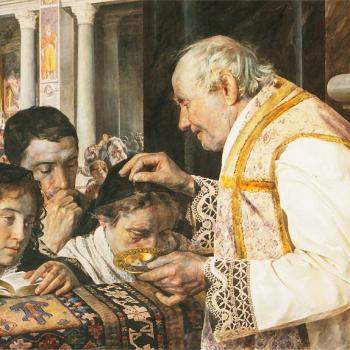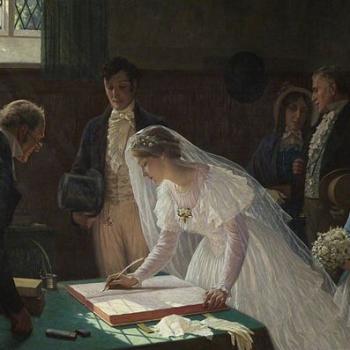I have been a member of the Consistent Life Network for more than 25 years. I joined in graduate school, back when it was still called the Seamless Garment Network. Cardinal Bernadin popularized the idea of a “seamless garment” ethic, (according to Wikipedia, Eileen Egan coined the term in the 70s); his goal was to get the Catholic pro-life community in the US to understand “pro-life” in the fuller context of Catholic Social Teaching. The organization itself is not Catholic, and the name of the organization got changed in the mid 1990s. But the idea of a consistent life ethic remains the same, and is fully compatible (if not exemplary of) Catholic Social Teaching.
I have never been particularly active in the CLN, though while I was active in the anti-death penalty movement in Connecticut I volunteered to be part of their speakers bureau. But recently, my fellow blogger, Julia Smucker, asked me if I would consider becoming a board member. As a board member I need to endorse the mission statement of the CLN:
We are committed to the protection of life, which is threatened in today’s world by war, abortion, poverty, racism, the death penalty and euthanasia. We believe that these issues are linked under a ‘consistent ethic of life’. We challenge those working on all or some of these issues to maintain a cooperative spirit of peace, reconciliation, and respect in protecting the unprotected.
The board has asked me to provide a reflection on my understanding of the consistent life ethic. Actually, to tell the truth, they asked me three months ago. I was busy with business travel, and my on-again, off-again writers block made it hard to get started, even as I posted other things. But I did finally start to think about it, but what took shape in my mind was not a philosophical statement but rather an episodic narrative about my own life. It is not a defense of what I believe, but rather what and how I came to believe in a consistent life ethic.
The death penalty
I should start with the death penalty, as this is an area where I was very active. I first started thinking about it in graduate school: In 1992 California, after a long hiatus, planned to resume executions with Robert Alton Harris. There were diffuse plans for a protest at San Quentin, and I wanted to go. I mentioned this to a friend and fellow grad student, who asked if I wanted to go to protest or to support the execution. He told me that he asked this because I was Catholic. At the time I did not know anything about the Church’s complicated and evolving stance on the death penalty; I just asserted that Catholics were opposed. I went, and prayed 15 decades of the rosary while holding a sign saying (if I remember correctly), “Forgive Harris, pray for his victims.”
My intuition, borne out of my Franciscan vocation (I became a professed Secular Franciscan the year before), was that the death penalty was contrary to both God’s mercy and justice and was a violation of the dignity of the human person. As Pope St. John Paul II so forcefully put it in Evangelium Vitae,
And yet God, who is always merciful even when he punishes, “put a mark on Cain, lest any who came upon him should kill him” (Gen 4:15). He thus gave him a distinctive sign, not to condemn him to the hatred of others, but to protect and defend him from those wishing to kill him, even out of a desire to avenge Abel’s death. Not even a murderer loses his personal dignity, and God himself pledges to guarantee this. (EV 9)
I moved to Connecticut and the issue moved to the back burner, since the state had not had an execution since 1960. There was a death penalty on the books and 12 men were on death row, but the appeals process was far from complete, and any potential executions were more than a decade away. But in 2005, I again found myself outside a prison, praying the rosary while waiting for a man to be executed. Connecticut had agreed to execute a volunteer, Michael Ross. who had waived his remaining appeals. The Connecticut Network to Abolish the Death Penalty, which had existed since the early 1980s, re-energized, and I found myself drafted to do religious outreach. We had a number of significant Protestant supporters, including the Episcopal Bishop of CT and the Conference Minister of the United Church of Christ in CT. The four Catholic bishops in the state also opposed the death penalty, but often seemed lukewarm in their opposition, so fearful of contamination from cooperating with liberals (who might support abortion) that they would not form a united front. And there were a lot of Catholics, priests and lay people, who actively supported the death penalty. For five years I went wherever I could to talk about the religious case against the death penalty, trying to mobilize the mass of Catholics to oppose it. (I became less active in CNADP after 2009 as the organization shifted to a paid, professional staff. But I was there in 2012 when the death penalty was abolished.)
During this time, as I prepared my talks, I read extensively, and became convinced (with theologian E. Christian Brugger) that the death penalty was, possibly, an intrinsic evil. More importantly, I began to understand that opposition to the death penalty must find its foundation and justification in a larger context, as one of many grave offenses against the human person. Again, quoting John Paul II from Veritatis Splendor, who was in turn quoting Gaudium et Spes, I offer a passage that I think clearly lays out the case for the kind of “prolife” or “whole life” ethic I was forming:
Reason attests that there are objects of the human act which are by their nature “incapable of being ordered” to God, because they radically contradict the good of the person made in his image. These are the acts which, in the Church’s moral tradition, have been termed “intrinsically evil” (intrinsece malum): they are such always and per se, in other words, on account of their very object, and quite apart from the ulterior intentions of the one acting and the circumstances. Consequently, without in the least denying the influence on morality exercised by circumstances and especially by intentions, the Church teaches that “there exist acts which per se and in themselves, independently of circumstances, are always seriously wrong by reason of their object”. The Second Vatican Council itself, in discussing the respect due to the human person, gives a number of examples of such acts: “Whatever is hostile to life itself, such as any kind of homicide, genocide, abortion, euthanasia and voluntary suicide; whatever violates the integrity of the human person, such as mutilation, physical and mental torture and attempts to coerce the spirit; whatever is offensive to human dignity, such as subhuman living conditions, arbitrary imprisonment, deportation, slavery, prostitution and trafficking in women and children; degrading conditions of work which treat labourers as mere instruments of profit, and not as free responsible persons: all these and the like are a disgrace, and so long as they infect human civilization they contaminate those who inflict them more than those who suffer injustice, and they are a negation of the honour due to the Creator”. (VS 80, quoting GS 27)
To be continued…..












